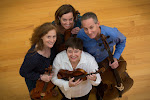Last
fall, I made a big life change: moving from Canada to the US indefinitely to
join the faculty of the University of Delaware.
Luckily, the first people I got to know in my new home were the Serafin
String Quartet. Before I was a member, before
even beginning to teach at the University of Delaware, my first experience here
was preparing for a concert with them when former violist Molly Carr had a
conflict. I was immediately drawn into their special world of
music-making. Apparently, I was also on trial for the job, and I can
assure everyone that if you are going to audition for anything, it's best to be
unconscious of the fact. Much more pleasant!
I want to talk a little about the rehearsal process I dove
into last August, as I feel that's at the heart of what makes this group so
wonderful. Quartet playing is about communication: you are all trying to
craft a powerful message to the audience, and as anyone who watched the recent
presidential debates can attest, there are thousands of tiny details that
affect the impact and the presentation of this message. The way four different
people with vastly different backgrounds, perspectives, and talents arrive at a
unified concept is fascinating. Firstly, there are the raw materials. Everyone
has their own unique way of hearing the piece they are playing together.
How they hear their own line, but also how they hear the group’s message can be
very different at times. What's amazing is that before any words are even
spoken, with sensitive listening, quartet musicians respond to what the others
are playing, and thus communicate their intentions. Like good friends or
family members who bring out the best in you, quartet mates challenge your
ideas. I’m an idealist, believing that
though the best product comes from experimentation with many ideas, we can
still arrive at a consensus. The
curiosity and openness of this group, but moreover the dedication to excellence when musical
ideas are formed, is truly inspirational.
Right away, the Serafins felt like the best musical friends I could hope
for.
I can’t resist taking a second here as I introduce myself to
say a word about the viola. Canadians
are notoriously poor self-promoters, likewise violists, but I think I can get away
with it in this, my first blog-post. For
me, the middle voices are the heart, the inner warmth of chamber music. Of course we have our solo moments and, like
all instruments in a string quartet, have to play many roles at different
times. But the essential role in much of
the classical repertoire we play is a contrapuntal inner voice, representing
the tenor or alto voice. In the works of
great composers (e.g. Mozart, Beethoven,
Brahms, all on the menu this delicious season!) the inner voices add an amazing
dimension. They are often the parts
lending subtle harmonic colour to a melody, or providing some rhythmic undercurrent
that transforms the meaning of the piece’s main line. In the case of Beethoven’s Harp Quartet,
which we will perform October 20th at Trinity Episcopal Church, the
viola provides a harrowing counterpart to the first violin’s serene opening melody in
the second movement. When I am an audience member and I catch
myself emotionally disengaged, I take a moment and listen to the workings of
the inner voices. Usually in moments I
am a weepy puddle. In fact this
technique is not recommended on dates, or any moments where you would prefer to
look respectable post-concert. However,
if you are seeking an intense, overwhelming classical music experience, the
inner voices are where it’s at!
Until next time,
Esme Allen-Creighton
Until next time,
Esme Allen-Creighton

No comments:
Post a Comment